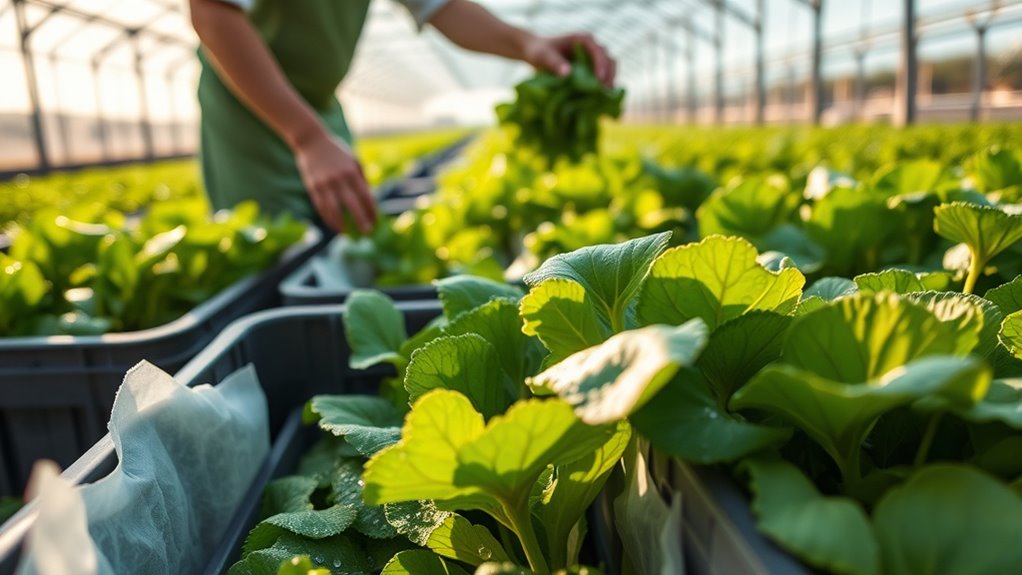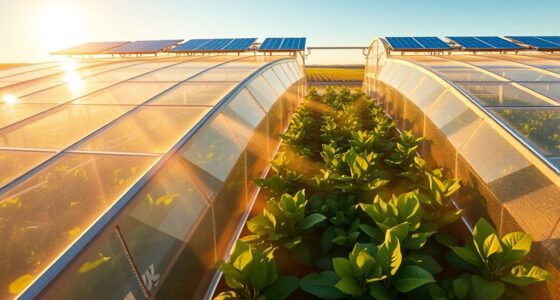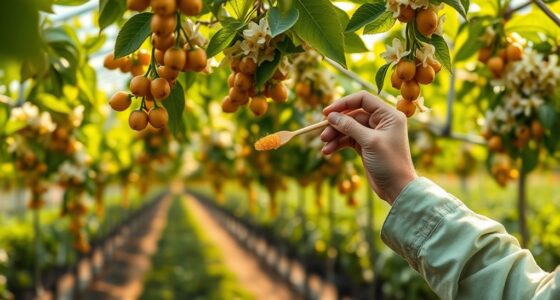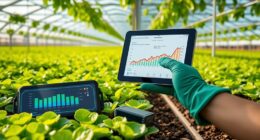To keep your greenhouse produce fresh, focus on gentle handling during harvest and use proper packaging with breathable or perforated materials to prevent bruising. Store crops at ideal temperatures—cooler for leafy greens and slightly warmer for fruits—and maintain consistent conditions. Good air circulation and humidity control help prevent mold and decay, while careful stacking minimizes pressure damage. Continuing along, you’ll discover more effective strategies to extend your produce’s shelf life and market quality.
Key Takeaways
- Use breathable, perforated packaging to protect produce and promote air circulation.
- Store greenhouse crops at optimal temperatures specific to each crop, like 1-4°C for leafy greens.
- Ensure proper air circulation and humidity control to prevent mold and decay during storage.
- Handle produce gently to avoid bruising, and organize storage for easy access and airflow.
- Combine effective packaging with consistent temperature management to extend freshness and reduce spoilage.
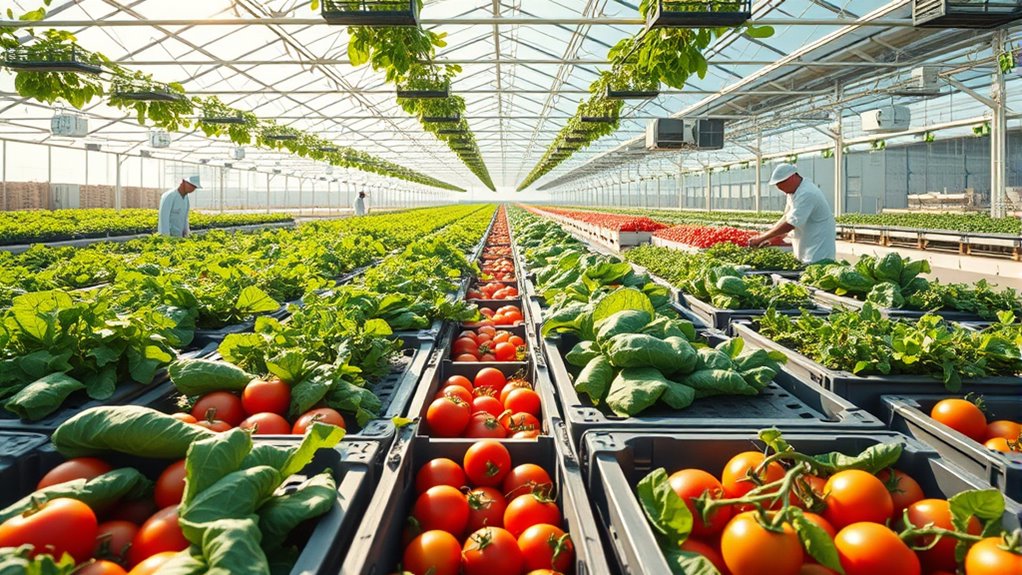
Post-harvest handling is a critical stage in ensuring that your crops maintain quality and maximize shelf life after harvest. Proper handling begins with the right packaging techniques, which protect your produce from physical damage, contamination, and dehydration. Using sturdy, breathable packaging materials helps prevent bruising and allows for air circulation, which is essential for reducing moisture buildup and spoilage. You might consider perforated containers or mesh bags for delicate crops, ensuring they’re well ventilated while still protected. Additionally, packaging should be tailored to the specific needs of your produce—some items require moisture-proof wrapping, while others benefit from inserts that reduce movement and impact during transport.
Equally important is managing storage temperature, a key factor in slowing down metabolic processes that cause ripening and decay. After harvesting, you should aim to store your greenhouse produce at temperatures suited to each crop’s requirements. For example, leafy greens often thrive at temperatures around 1-4°C (34-39°F), while tomatoes and other fruits may need slightly warmer conditions. Maintaining consistent storage temperatures helps prevent stress that can accelerate spoilage, mold growth, and quality deterioration. To achieve this, use reliable refrigeration units or climate-controlled storage rooms, and regularly monitor conditions with calibrated thermometers. Fluctuations in temperature can cause condensation or freeze damage, so stability is essential.
In addition, effective air circulation within storage areas helps reduce humidity levels and prevents the development of mold and decay. Combining effective packaging techniques with suitable storage temperature creates a synergistic effect that prolongs the freshness of your produce. For instance, packaging that reduces moisture loss and physical damage works hand in hand with temperature control to slow microbial growth and enzymatic activity. This means your crops stay fresher longer, reducing waste and increasing marketability. It’s also essential to handle your produce gently during packaging and storage to prevent bruising, which can become a site for decay. Proper stacking and organization within storage units minimize pressure points and improve air circulation, further extending shelf life.
Frequently Asked Questions
What Are the Best Storage Temperatures for Different Greenhouse Crops?
When considering the best storage temperatures for your greenhouse crops, focus on temperature regulation and crop-specific storage needs. You should keep leafy greens around 32°F to 40°F to maintain freshness. Tomatoes thrive at 55°F to 70°F, while herbs prefer slightly cooler temperatures of 40°F to 50°F. Properly adjusting storage conditions based on each crop’s requirements helps extend shelf life and preserve quality effectively.
How Can Humidity Levels Be Controlled Effectively Post-Harvest?
To maintain ideal humidity levels, you need effective humidity regulation and moisture control. Use humidifiers or dehumidifiers based on your greenhouse’s needs, and monitor humidity with reliable gauges. Ventilate properly to prevent excess moisture, which can cause mold or rot. Consistent air circulation helps distribute humidity evenly, ensuring your produce stays fresh longer. Regularly check and adjust humidity settings to match the specific requirements of your crops.
What Packaging Methods Extend Produce Shelf Life?
To extend your produce’s shelf life, you should consider effective packaging methods like modified atmosphere packaging and vacuum packaging. Modified atmosphere adjusts oxygen and carbon dioxide levels, slowing spoilage. Vacuum packaging removes air, reducing microbial growth. These techniques help preserve freshness, flavor, and texture by controlling the environment around your produce. Using these methods guarantees your greenhouse products stay fresh longer, reducing waste and improving customer satisfaction.
How Do Ethylene Inhibitors Improve Produce Freshness?
Imagine a world where produce ripening is perfectly controlled—that’s what ethylene inhibitors do. By managing ethylene levels, you slow down the natural ripening process, keeping your produce fresher longer. Effective ethylene management prevents spoilage, extends shelf life, and maintains quality. You’ll notice crisper, more vibrant produce on shelves or in storage, making your harvest more appealing and reducing waste. Ethylene inhibitors truly are the secret to fresher, longer-lasting greenhouse produce.
What Are Common Post-Harvest Diseases to Watch For?
You should watch out for common post-harvest diseases like mold growth and pest infestation, which can quickly spoil your produce. Mold often appears as fuzzy patches on surfaces, while pests may cause physical damage or carry pathogens. Regular inspection helps you catch issues early. Maintain good hygiene, control humidity, and guarantee proper storage conditions to prevent these diseases and keep your greenhouse produce fresh and market-ready.
Conclusion
By mastering proper post-harvest handling, you can substantially extend your greenhouse produce’s freshness and shelf life. Remember, studies show that improper handling can lead to a 20-30% loss in produce quality, costing you both money and reputation. So, invest time in gentle harvesting, proper cooling, and careful packaging. These small steps make a big difference in maintaining top-quality produce from your greenhouse to your customers.
